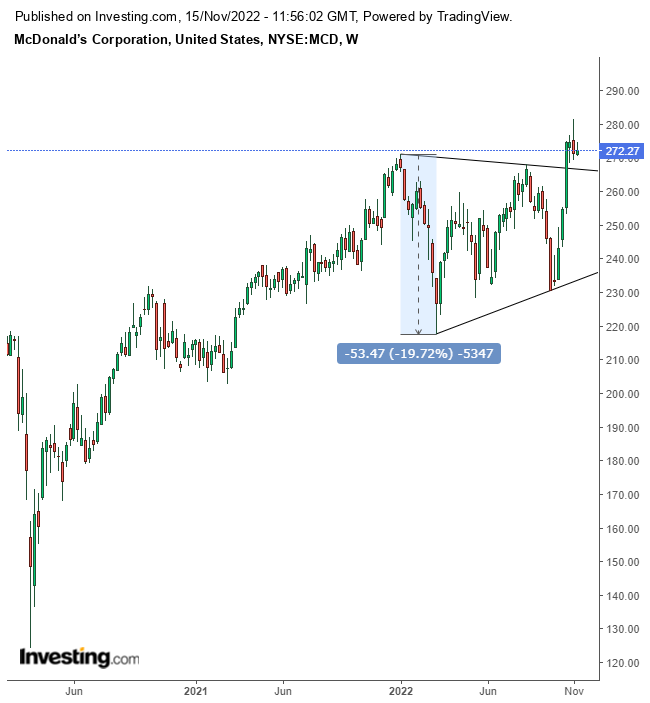Chart of the Day: McDonald’s to $320 as Recession Hedge
2022.11.15 08:46
[ad_1]
Morgan Stanley the US may avoid a recession in 2023 while Europe and the UK will not be so lucky. However, it’s not a celebratory call as the investment bank is warning that the US Federal Reserve’s aggressive battle against inflation will meaningfully slow job growth, increasing and slowing the economic expansion to 0.5%. And this is the optimistic view.
Meanwhile, Goldman Sachs, JPMorgan, and many other economists are predicting a recession. Tesla (NASDAQ:) chief, Elon Musk warns “the economic picture ahead is dire,” and Amazon (NASDAQ:) founder, Jeff Bezos warns Americans to “prepare for the worst.”
A leading indicator of a recession, the yield curve, is currently at its since the 1980s. The yield curve inverts as investors expect the Fed to ease tightening in response to a recession, reducing long-term rates, while at the same time, the yield on shorter debt fails to respond immediately.
Remember how aggressively the Fed has been recently while inflation remains stubbornly high. This environment of an unforgivingly tightening monetary policy rapidly increases the odds of a recession and has pushed stocks into a bear market.
Examining the major indices illustrates a business cycle winding down. The is down 30% year to date (ytd), even after a 12% rebound since the Oct. 13 low. The shed a little more than half of that, losing 17.7% ytd. Finally, the most reliable mega caps listed on the retreated slightly more than half of that again, slipping 9.25%.
Analyzing the S&P 500 sectors shows the divergence across sectors. , bloated during coronavirus lockdowns, has lost more than a third of its value, with a 35.9% drop this year. The second-worst performer ytd is which is down 30.2% as luxury goods consumers ease spending and has sold off 24.1%.
Conversely, the defensive sectors have outperformed. , which includes goods that are considered essential, and all fell but just around 5%.
Fast food giant, McDonald’s (NYSE:) performance has overshadowed all of these results. The shares recently hit an all-time high and now hover 3.3% below that record.
Will this trend continue? I think so.

McDonald’s Weekly
MCD completed a ten-month-long Symmetrical Triangle. The upside breakout demonstrates that the increasingly tenacious struggle between buyers and sellers, as they gained ground toward each other, ended with a bullish victory. Demand absorbed all available supply at these levels, and buyers wanted more, raising their bids. Statistically, breakouts trigger an upward market orders-chain reaction along with human psychology. Technicians measure the height of the pattern, $53.47, and add that to the $266.96 breakout point, targeting $320.
Trading Strategies: Long Position
Conservative traders should wait for a new high to demonstrate ongoing demand.
Moderate traders would look for an entry closer to the pattern to reduce risk.
Aggressive traders could enter at will.
Trade Sample
Entry: $270
Stop-Loss: $260
Risk: $10
Target: $300
Reward: $30
Risk-Reward Ratio: 1:3
Disclaimer: At the time of publication, the author had no positions in the securities mentioned.
[ad_2]








